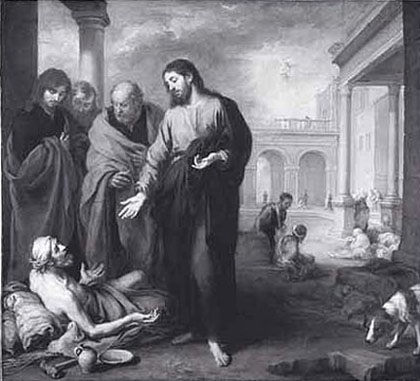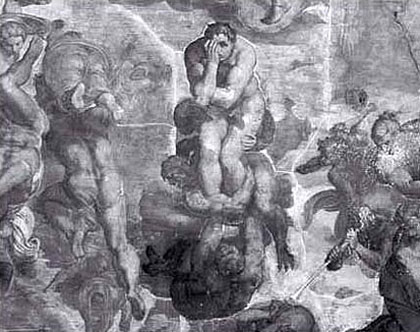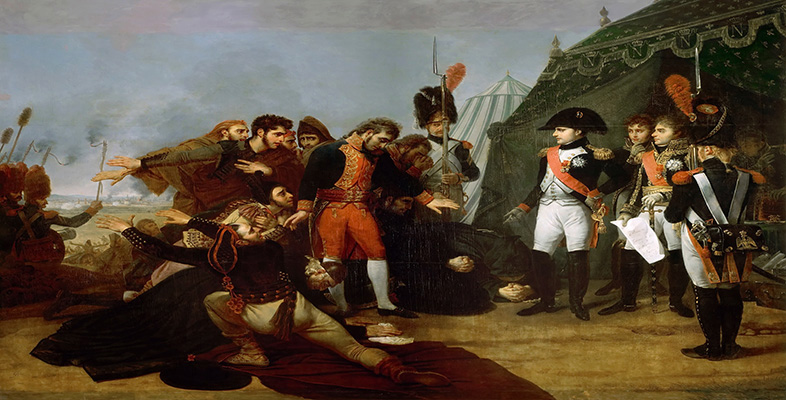3.3 The use of religious imagery
What is paradoxical about this painting is that, while Bonaparte is ostensibly presented here as the exponent of rational values, the impression that it conveys is not so much of a modern secular leader as of a saviour in the Christian tradition. His hand extended towards one of the plague-stricken suggests that he has miraculous powers of healing. As one of Gros's fellow artists put it, in an ode to the painting: ‘the hero can cure at a glance’ (quoted in Porterfield, 1998, p.56). It thus effectively attributes to Napoleon something very like ‘the king's touch’, the miraculous power to heal scrofulous abscesses attributed to French monarchs since the Middle Ages. The only problem with such an interpretation is that it is a bit too neat and fails to account for the sheer abundance of religious allusions. Napoleon might also be compared to St Roch, the patron saint of plague sufferers, or even to Christ. (Given that this work dates from after Napoleon had made the Concordat with the Church, it is safe to assume that these religious references are intended to convey a specifically Christian meaning. In this respect, Gros's use of traditional religious imagery differs fundamentally from that in David's painting of Marat. In the latter case, the artist cannot have intended to identify Marat with Christ, in view of the Jacobins’ replacement of Christianity with deism as the official religion.)
The composition, with its colonnades, recalls paintings of Christ healing the paralytic at the pool of Bethesda (see Figure 6); there is even a blind man groping his way forward at the right as if hoping for a miraculous cure. Nor do the religious resonances stop here; the naked figures of the plague-stricken resemble the damned in hell, cut off as they are from the radiant light around the Christ-like leader. In fact, the figure seated at the left is based on one of the damned in Michelangelo's Last Judgement in the Sistine Chapel (see Figure 7).


Gros's painting is thus positively overloaded with allusions to religious images, in much the way that Ingres's portrait of Napoleon enthroned is crammed with symbols of divine power. Despite the differences of style and genre between these works, both testify in this respect to the problem of embodying authority in an iconography drawn from the art of the past (that is, a standard repertoire of stock poses, motifs, symbols, etc.) in a post-revolutionary culture in which the equivalence of monarchical and Christian power had collapsed. In consequence, the meanings of iconography had become unfixed. Thus, Napoleon could be depicted as a sacred monarch, but there was no guarantee that viewers would take the image in the spirit in which it was intended; it would be likely, for example, to strike a royalist as blasphemous. However, it is also important to note a fundamental difference in approach between Gros and Ingres. The latter uses iconography in an entirely literal-minded fashion, as if its former meanings still automatically applied and as if Napoleon's claim to the throne was undisputed. Gros, by contrast, enters whole-heartedly into the pragmatic, instrumentalist spirit of Napoleonic propaganda, combining as he does sacred and secular, religious and rational justifications for Bonaparte's rule in a single painting without regard for ideological coherence. These contradictions were inherent in the regime, which owed its existence to the Revolution but, by the time that Jaffa was painted, was moving steadily towards monarchy.
These contradictions were also inherent in the Egyptian campaign, which supposedly served to extend the enlightened (that is, secular, rational and modern) values of the Revolution into new regions but, in practice, substituted imperial expansion for revolutionary goals (it was, in fact, the prelude to France's colonization of North Africa in the nineteenth century). Just as Gros's Jaffa introduces a religious dimension into an image that ostensibly promotes the virtues of rationality, so his sketch for The Battle of Nazareth compromises its apparently ‘scientific’ documentary approach by altering the topography to give prominence to Christian holy sites such as Mount Tabor (which appears on the left when it should really be on the right); in fact, Bonaparte named the battle to highlight the notion of a Christian victory against the infidel, even though it did not take place that close to Nazareth. Gros's sketch also presents a moral contrast between European civilization and Oriental barbarism, which owes at least as much to Christian tradition as to the Enlightenment; in the centre, a French soldier spares the life of a surrendering foe, while a Turk in the lower left prepares to cut off the head of a defenceless enemy, only to be stopped by a bullet. The Arab figures caring for the sick in Jaffa also conform to European stereotypes but in a different, less overtly denigratory, fashion; their calmness in the face of the horrors of the plague was attributed by one Salon critic to their typically Oriental fatalism and passivity. As such, they can be seen as willing collaborators in the French colonial campaign. The point is that while Gros's painting acknowledges something of the horrors that took place in Jaffa, it works to conceal not only Bonaparte's crimes there but also the coercive and violent nature of the entire enterprise.
